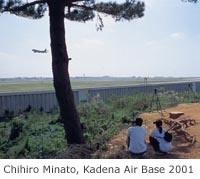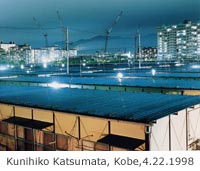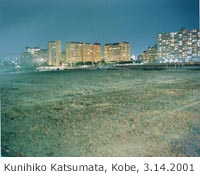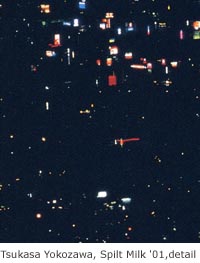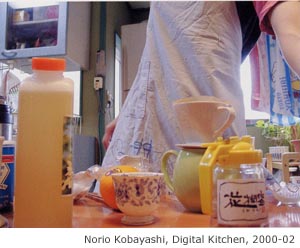Click. In that instant that you push the camera's button you capture
time and space. An exhibition at the MoMAT, 'site/sight' focuses on place
and perspective to survey contemporary Japanese photography.
Hands grapple yogurt lids, coffee splashes into cups, socked feet stand
in front of an opened refrigerator, a pair of legs wearing only a few
Band-Aids -- Norio Kobayashi photographs life in his kitchen. He captures
the flurry of daily activity at the control center of his home. These
are published regularly on his website and are on show in this exhibition
printed onto large format matte paper and displayed on the wall and floor
of the gallery.
However, this is no 'webcam' voyeurism . These are insights, scenes Ð
often from quirky odd angles -- of the comings and goings of household
Kobayashi. Color jumps from the images. Blazing reds and blues heighten
the activity. Remarkable images of unremarkable moments are captured by
Kobayashi's keen eye.
A moment of study, his wife consults a cookbook recipe, poised with hands
covered in flour. In another she is caught, head in a bowl, woofing the
last of her rice.
'Military bases and sacred grounds' is the title and subject of the series
by Chihiro Minato. The best of these capture aspects of being outside
looking in, such as her images of Okinawan bases with people standing
at the perimeter fences looking in. Restricted from access to military
installations, people become tourists in their own country.
In a breathtaking series of works, Kunihiko Katsumata, uses photography
to document change. In his images, the viewer must spot the differences
and search for the similarities of scenes photographed at different times.
Katsumata focussed his lens on Kobe in the late 1990's and returned to
many of these sites recently. His series titled 'Phases', Katsumata documented
many examples of the rapid change in the city. Higashinada 1998 and 2001
is an amazing example. A 1998 photograph, taken in the evening, depicts
warehouses filling acres of land. In the distance are two groups of high-rise
apartment blocks. A 2001 image, taken at the same time of day, shows no
warehouses, just a broad vacant field. The background contains only one
apartment block from the previous image but includes a horizon of new
ones. By ripping up a series of photographs into strips and reassembling
them, Yoshiko Ito creates panoramas, which capture a series of events
unfolding over time. Hiroyo Kaneko focuses her lens on Nagasaki and links
the people places and history of the city in and insightful series of
images. Captured in over 60 paintings, Mont Sainte-Victoire in Aix-en-Provence,
France, has become synonymous with the great French 19th century painter
Paul Cezanne. Risaku Susuki revisits and documents aspects of the area
which so obsessed Cezanne. Risau's work is part homage and part a recapturing
of the mountain landscape. Land is also recaptured in the images of Noguchi
Rika. She records a series of events as silent witness watching from a
distance. Her series on display records workers on a land reclamation
site. 'Spilt Milk' is the unusual title of Tsukasa Yokozawa's visually
stunning images of cities photographed from the air at night. His images
are abstracts of light and color , capturing a specific moment of descent
in a plane. In all eight photographers are included in this large and
elegantly displayed exhibition, curated by Rei Masuda. Each photographer
makes an eloquent visual comment on the unique nature of photography to
document
